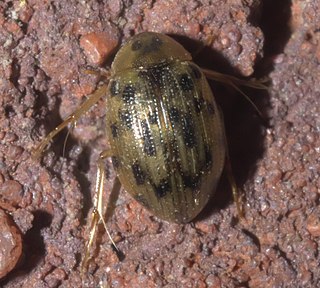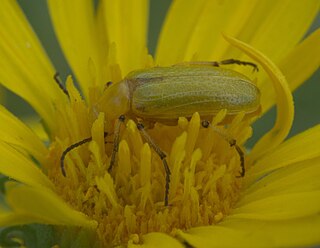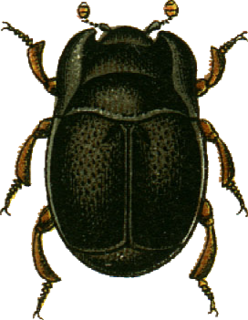
Thomas Say was an American entomologist, conchologist, and herpetologist. His studies of insects and shells, numerous contributions to scientific journals, and scientific expeditions to Florida, Georgia, the Rocky Mountains, Mexico, and elsewhere made him an internationally known naturalist. Say has been called the father of American descriptive entomology and American conchology. He served as librarian for the Academy of Natural Sciences of Philadelphia, curator at the American Philosophical Society, and professor of natural history at the University of Pennsylvania.

Berosus is a genus of beetles in the family Hydrophilidae, the water scavenger beetles. The genus contains 273 species. It is distributed worldwide.
Berosus aculeatus is a species of hydrophilid beetle native to the United States and Cuba. It was originally described by John Lawrence LeConte in 1855 and is characterized by prolonged apices of its elytra.

Berosus pantherinus is a species of hydrophilid beetle native to the United States. It was originally described by John Lawrence LeConte in 1855 and is characterized by having ten dark spots on each elytron.
Berosus pugnax is a species of hydrophilid beetles native to the United States. It was originally described by John Lawrence LeConte in 1863 and is characterized by having emarginate apices on its elytra.
Berosus ordinatus is a species of hydrophilid beetles native to the United States, specifically in the states of Maryland, Delaware, New York, New Jersey, Pennsylvania, Connecticut, and Rhode Island. It was originally described by John Lawrence LeConte in 1855 and is characterized by slightly divergent and prolonged elytral apices.
Berosus corrini is a species of hydrophilid beetles native to the United States. It was originally described by David P. Wooldridge in 1964 and is characterized by the lack of striae on its elytra, larger size, two projections on its sternal emargination, and laterally-projecting dorsal edges on the parameres.
Hygrotus sayi is a species of predaceous diving beetle in the family Dytiscidae. It is found in North America.
Agrilus sayi, the bayberry agrilus, is a species of metallic wood-boring beetle in the family Buprestidae. It is found in North America.

Zonitis sayi is a species of blister beetle in the family Meloidae. It is found in Central America and North America.
Plegaderus sayi is a species of clown beetle in the family Histeridae. It is found in North America.

Plegaderus is a genus of clown beetles in the family Histeridae. There are more than 30 described species in Plegaderus.

Lytta sayi, the Say blister beetle, is a species of blister beetle in the family Meloidae. It is found in North America.
Macrosiagon sayi is a species of wedge-shaped beetle in the family Ripiphoridae. It is found in North America.
Gyrinus sayi is a species of whirligig beetle in the family Gyrinidae. It is found in North America.
Enochrus sayi is a species of water scavenger beetle in the family Hydrophilidae. It is found in North America and Oceania.

Curculio sayi, the small chestnut weevil, is a species of true weevil in the family of beetles known as Curculionidae. It is found in North America.The distribution of this species extends from Canada and Massachusetts to North Carolina, Tennessee, and Ohio, and probably farther westward. The average length of the body is about 1/4" (6mm).
Colaspis flavocostata is a species of leaf beetle from North America. It is found in the coastal states of the United States; its range spans from Mississippi to Florida and to South Carolina. It was first described by the American entomologist Charles Frederic August Schaeffer in 1933.
Carpophilus sayi is a species of sap-feeding beetle in the family Nitidulidae. It is found in North America,and named after Thomas Say.
Choragus sayi is a species of fungus weevil in the beetle family Anthribidae. It is found in North America.







